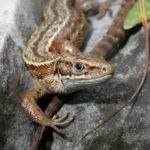The Common Lizard
The Common Lizard
Zootoca vivipara

Hands up dear readers, who assumed the Lizard is encountered mainly on hot, balmy holidays around the Mediterranean? A surprising truth, to you dear readers, the Lizard can be found throughout the UK.
The Common Lizard is found more north than any other Eurasian land based reptile, even as far as the Arctic Circle
A few facts to set the scene. Lizards have a life span of five to six years, an approximate length of 10 – 12 cm and are viviparous, like Adders, giving birth rather than hatching eggs, producing up to ten offspring. They hibernate beneath rocks and fallen logs. Their diet includes flies, spiders and snails.
In Britain their population is in decline due to habitat loss (yet again!). Lizards are timid, lightning quick and worship the sun. They live in open woodland, heath and moorland, sometimes in gardens, usually staying close to dense cover and always needing access to water. They are more common than you think: the trick is to spot them
Top spotting tips: walk slowly and focus on the spaces between dry paths and vegetation that catch the sun. Basking places include brush piles and low logs. Listen for rustling as they dart for cover and return to this place as they tend to return to their favoured spots
Beware: Lizards can bite when feeling threatened. Do not handle them.
Surprise: when under attack from a predator (large bird or rat) Lizards will often shed their tail, a distracting tactic to enable escape
If you keep them, for example in an enclosed garden space, their main nutrient requirement is water. They like to lie in water peridocially to shed their skins. Try offering a shallow dish, lined with dead lives on the bottom, sprayed with water. Lizards can become a (distant) friend if treated with consideration
James Stewart
Photograph by Steve McWiilam